The sisters Betty MacDonald (1907-1958) and Mary Bard Jensen (1904-1970), both writers, grew up in Seattle. Betty MacDonald authored the international bestseller, The Egg and I, among others, and Mary Bard wrote the Best Friends series for girls, among others. This is a slideshow of their King County homes and lives. It was written by Paula Becker and curated by Priscilla Long. The photographs of the writers' homes were taken as part of the WPA-funded King County Land Use Survey in 1937-1939.
MacDonald, Betty, and Mary Bard: A Slideshow Tour of their King County Homes
- By Paula Becker
- Posted 6/11/2002
- HistoryLink.org Essay 7035
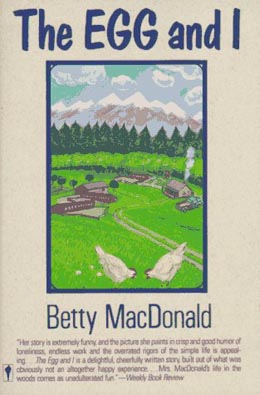
The sisters Betty MacDonald and Mary Bard Jensen, both writers, grew up in Seattle.
Betty MacDonald was the beloved author of four autobiographical books: The Egg and I, The Plague and I, Anybody Can Do Anything, and Onions in the Stew. She also wrote books for children: the Mrs. Piggle Wiggle series, and Nancy and Plum. All her books except Nancy and Plum are (as of 2002) in print.
Mary Bard Jensen, who wrote under the name Mary Bard, wrote three autobiographical books: The Doctor Wears Three Faces, Forty Odd, and Just Be Yourself. She also wrote the three-volume Best Friends series for girls. All of Mary's books are out of print.
Mary and Betty came from a warm, loving, resilient family. Their books cover the time period encompassing the Great Depression, World War II, and the development of nuclear technology.
Both writers stress home and family as a safe haven from a larger world. This is one reason their books remain so resonant: They lovingly describe what was home to them -- the homes they made and homes where they were sheltered.

2212 13th Avenue N (renamed Everett Avenue in late 1918. The current address is 2212 Everett Avenue E); built 1909. Status: exterior unchanged.
Darsie and Sydney Bard moved their family (Mary, Betty, then called Betsy, Cleve, and Dede) here from Butte, Montana, in 1916. Darsie was a mining engineer, officed in the Smith Tower. John P. Jacobsen, vice-consul of Denmark, and his wife Clara previously owned the house. After one year, the Bards moved on to Laurelhurst.
"When I was nine years old we moved to Seattle ... . One of the houses we lived in had belonged to the Danish Consul and had a large ballroom in the basement which Daddy immediately turned into a gymnasium ... Every night he forced us into this torture chamber for a workout ... . We did not want to be healthy. We wanted to go to the movies, read the funny papers, and relax like all the other unhealthy children we knew" (The Egg and I).
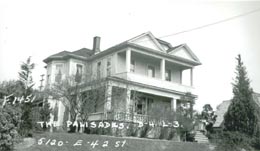
5120 E 42nd Street (now NE); built 1900. Status: minor exterior renovations. Garage added under the house. Grounds greatly reduced.
"When I was eleven ... we bought a house in Laurelhurst near the water. This was a fine big place with an orchard, a vegetable garden, tennis courts and a large level lawn for croquet" (The Egg and I).
Betty MacDonald fans will note that this is the house where Mary, Betty, and brother Cleve painted the roof.
Darsie and Sydney Bard bought this house in 1918. It was here the following year that Sydney received the news of Darsie's death from pneumonia on a mining trip in Butte, Montana, and five months later gave birth to her youngest child, Alison. The Bard family lived here until about 1925.
The Bard family's finances grew increasingly strained in the years following Darsie Bard's death. Sydney briefly managed a tearoom called The Mandarin at 4311 15th Avenue NE, located in the University District on the present parking lot of University Book Store.
Sydney's longstanding role as host to her late husband's associates and later her five children's many friends made it difficult for her to charge people she knew for the food, and the venture lasted only one year. The family had a dairy farm near Chimacum in Jefferson County from 1926 to 1928, then rented a home or homes in Jefferson County until June 1930.
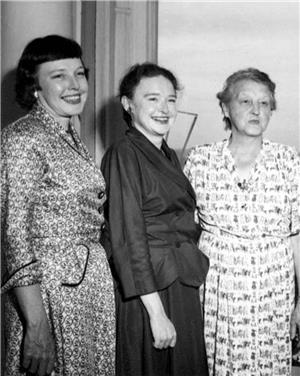
Mary attended the University of Washington for a time, until she reluctantly withdrew to help support the family.
Blanche Caffiere (1906-2006), a life-long friend of the Bard family, writes in her memoir, Much Laughter, A Few Tears, that they moved for a time to the Olympic Peninsula: "Although Betty's brother, Cleve, was only seventeen and had no farming experience, he thought farm life would be wonderful. Practicality was swallowed up in romanticism" (p. 37).
The Bards purchased the farm which had so entranced them, but were not successful as farmers. The family (by that time consisting of Elsie/Sydney Bard, son Cleve, daughters DeDe and Alison, and grandmother Anne Elizabeth Bard -- "Gammy") was enumerated in the 1930 United States Census on their farm in the community called Center.
Mary taught ballet classes in Port Townsend to help make ends meet, but by the time of the 1930 census she was living by herself in Seattle. Government inspectors soon discovered that the Bards' herd of cows was tubercular. The ensuing slaughter of the animals put an end to the Bards' turn as farmers.
Sometime during 1930, the Bards (with the exception of Betty) were back in Seattle.
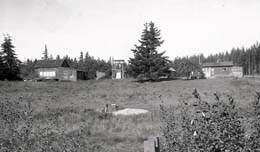
On July 9, 1927, Betty married Robert Heskett and lived with him on a chicken farm on Swansonville Road in the Chimacum Valley on the Olympic Peninsula. In 1945 she recounted the years of their marriage on a chicken farm in her bestselling book, The Egg and I.
In 1930 or 1931, Betty left the marriage, returning to Seattle with her two young daughters, Anne and Joan. The house, the chicken coop, and all other farms structures have been demolished, but the site has been commemorated by the renaming of the old rural route -- Egg and I Road.
Betty's house was number 711.

6317 15th Avenue NE, built 1910. Current status: This house was demolished on July 24, 2012.
The Bards lived here when this picture was taken.
Sydney Bard bought this house about 1930 and lived there with various combinations of her children (Mary, Betty, Cleve, Dede, and Alison), Betty's daughters Anne and Joan, and friends until 1942. Pictured are Betty MacDonald, Sydney Bard, and Mary Bard Jensen in 1949.
The household was a haven during the darkest days of the Great Depression, and many friends took shelter there for days, weeks, or even years at a time. Mary's friendship with Florence and Burton James, founders of the Seattle Repertory Playhouse, meant that the household often played host to impromptu cast parties.
Roosevelt High School (shown in 1952), Betty's alma mater, is one and one-half blocks north.
"To me that night, and always, that shabby house with its broad welcoming porch, dark woodwork, cluttered dining room plate rail, large fragrant kitchen, easy book-filled firelit living room, four elastic bedrooms -- one of them always ice-cold -- roomy old-fashioned bathrooms and huge cluttered basement, represents the ultimate in charm, warmth and luxury" (Anybody Can Do Anything).

As children, the Bard siblings accompanied Sydney on weekly shopping trips to Pike Place Market, and Mary and Betty both wrote of their deep affection for the market and its many charms.
Manning's Coffee Shop, where Betty and Mary shared their bag lunches, is currently occupied by Lowell's Restaurant. The upstairs dining room remains much as she describes it.
"We took our sandwiches, which we had brought from home ... and walked to the Public Market where for five cents we could get an unlimited number of cups of wonderful fresh-roasted coffee ... . The dining room was three flights up in the market loft, so we climbed the stairs, got our coffee, climbed more stairs and sat down at a large table by the windows ... commanding a magnificent view of the Seattle Waterfront, the islands and Puget Sound" (Anybody Can Do Anything).

Firland Tuberculosis Sanatorium, 19303 Fremont Avenue N (now Shoreline). Current Status: exterior unchanged; modern buildings have been added and suburban houses have taken over the forest that surrounded the property in Betty's day. This facility is now owned by Crista Ministries.
Betty MacDonald spent almost a year here (1938-39), and emerged cured of tuberculosis.
"We entered The Pines by a long, poplar-lined drive. On either side were great vine-covered Tudor buildings, rolling lawns, greenhouses and magnificent gardens. It might have been any small endowed college except that there were no laughing groups strolling under the trees" (The Plague and I).

During her year at the Firland Sanatorium, Betty developed a friendship with her Japanese roommate, whom she calls Kimi in The Plague and I.
In real life, Kimi was Monica Sone. Betty was later instrumental in the publication of Sone's book, Nisei Daughter, an important resource about the Japanese American experience in Seattle before, during and after Japanese internment during World War II.
The scenes pictured are from the book by Frederick G. Hamley, Firland: A Story of Firland Sanatorium.
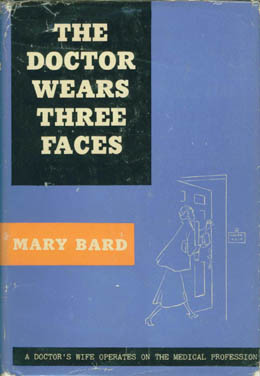
On June 19, 1934, Mary Bard married Dr. Clyde Jensen, an internist and pathologist who had established a practice in Seattle several years earlier. Jensen was the founder of the pathology laboratory at Harborview Hospital and later became an advocate for the establishment of the University of Washington School of Medicine.
Mary, whose earnings in the advertising field had been the Bard family's main support during the early years of the 1930s, wrote about her transition to married life and her indoctrination into her new role as a physician's wife in The Doctor Wears Three Faces.
In her books Mary refers to Clyde, whom she and all their friends called Jens, as Dr. Jim Jay.

706 Bellevue Avenue N (now E), built 1905. Status: exterior unchanged. Clyde and Mary lived here during the first year of their marriage, 1934-1935.
"... the grateful patient had come back from Alaska, decided on the spur of the moment to sell her house and had given us our choice of buying it or moving in two weeks. We didn't have enough money for the down payment. Jim's new basal metabolism machine and electrocardiograph had taken care of that" (The Doctor Wears Three Faces).

The Arcadia Apartments, 1222 Summit Avenue. Built 1916. Status: exterior unchanged.
Clyde and Mary lived here briefly in 1936, moving just after the birth of their oldest daughter Mari. Maynard Hospital was directly across the street.
"... Jim and Pete came bursting in ... they had spent the whole afternoon hunting apartments, and had found two in the same building ... . They had not chosen the apartments because they were light and sunny and had two bedrooms. They had chosen them because they were across the street from Maternity Hospital and would be so convenient for night calls ... . Maggie and I both hated the apartment house on sight" (The Doctor Wears Three Faces).
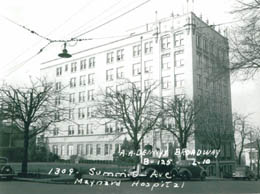
Maynard Hospital, later Seattle General, which Mary refers to as "Maternity" and "General," 1309 Summit Avenue. Built 1928. Clyde Jensen was an attending physician here. Status: demolished.
"On May twenty-second, with the brooding intensity of a prisoner watching the free flight of birds from his cell window, I looked longingly across the street at Maternity Hospital. The blue lights of the delivery room were as elusive as a will-o' the-wisp and the curtains blowing in the O.B. patients' ward beckoned ceaselessly" (The Doctor Wears Three Faces.)

623 37th Avenue, built 1910. Status: demolished.
The house that currently stands on this site was built in 1981. Clyde and Mary bought this house in June 1936, and it was to this house that they brought newborn Mari. Salli was born in September 1937, and Heidi in 1939. The Jensen family lived here when this picture was taken. They sold the house in 1942.
"We parked our car on a steep sidehill and walked down a little path. Clinging staunchly to a ledge were five small, nondescript Dutch Colonial houses, each with a neatly fenced or hedged yard and each gazing serenely at a breathtaking view. 'It's the third from the end, the yellow one. Those overhanging eaves make it look like a toadstool,' Jim said" (The Doctor Wears Three Faces).
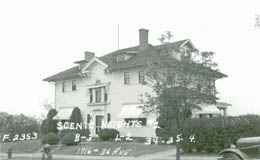
1716 36th Avenue, built 1910. Status: exterior unchanged.
Clyde and Mary bought this house in 1942, around the time Clyde entered the Navy during World War II. This is the house the Jensens lived in during the events recounted in Forty Odd and Just Be Yourself -- the house in which Mary's Brownie troop met (pictured about 1947), and in which Mary wrote her books. The family lived here until 1958.
"Our house braces its feet on the brow of a hill in the central, older portion of town ... to the south there is a large side yard used as a playground by the whole neighborhood because it is the only area which is flat ... . We bought the house primarily because of the view and also because it was large, old, inexpensive and just ten minutes from the hospitals. The architecture ... is what is known locally as 'early Lumber Baron' or square, three-storied and white. Although supposedly colonial, it actually resembles an enormous refrigerator" (Just Be Yourself).

5041½ 22nd Avenue NE.
In April 1942, Betty married Donald C. MacDonald. For the first few months of their marriage, Betty and Don lived in a duplex on a steep hillside on the eastern edge of the University District. In October 1942, Betty, Don, Anne, and Joan moved to Vashon Island. (Pictured are Betty, Don, and daughter Joan buying eggs on Vashon Island in 1946.)
"Don ... shared a rather dank, dark hillside duplex just off the campus of the University of Washington. We spent our weekend honeymoon (all that was allowed defense workers) in the apartment sans the room-mate but avec the mildew ... . Sunday evening Don and Anne and Joan and I were sitting in front of the fire ... when the very charming Japanese professor, who with his wife lived on the top part of the duplex, came down and told us that they were being sent to an internment camp and we could have their apartment ... .We thanked them fervently, but felt like grave snatchers as we piled into the car and raced over to see the landlord ... .The upstairs apartment was light and airy, had a woodburning fireplace, a view of Mt. Rainier if you had good eyes ... and a studio couch in an alcove for Anne and Joan" (Onions in the Stew).
Shown is MacDonald signing The Plague and I at University Book Store in 1948. Mary Bard stands at the upper left.
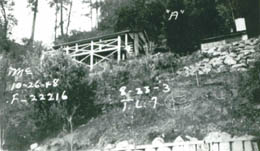
11814 Dolphin Point Trail, Vashon Island. Built 1935. Current Status: exterior unchanged.
Betty, Don, Anne, and Joan moved to Vashon Island circa 1942. It was while living in this house that Betty (at Mary's urging) wrote and published The Egg and I, quickly achieving worldwide acclaim. Don and Betty lived in this house until their move to Carmel Valley, California, in the mid-1950s.
"As we admired the huge virgin firs against the blue sky, breathed deeply of the fresh salty air and listened to the shrill happy sounds coming from the houses below us on the shore, I said again, 'Don't you have that feeling, Don? That this house was meant for us?'" (Onions in the Stew).
Pictured is Betty MacDonald and her two daughters. The photo appeared in Life magazine in 1946.
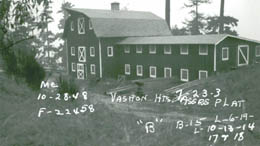
12000 99th Avenue S.W., Vashon Island. Built 1948. Status: exterior unchanged. Now operated as the Betty MacDonald Bed and Breakfast.
This is the barn and chicken coop that Betty and Don built adjacent to their Vashon home following Betty's success with The Egg and I. For several years the MacDonalds kept chickens and sold the eggs both on Vashon and in Seattle at Pike Place Market. Betty MacDonald is posing here with her ubiquitous Egg in 1946.

Betty MacDonald (pictured here in 1946) and Mary Bard maintained a close relationship for all of their lives. Betty credits Mary's inspirational determination and influence on her throughout her books. She dedicated The Egg and I "To my sister Mary who has always believed that I can do anything she puts her mind to." Mary dedicated The Doctor Wears Three Faces "To my sister Betty, who egged me on." The sisters spoke to each other by phone daily, often reading manuscripts back and forth. "Mrs. Jensen values her sister's criticism of her work second only to their close and life-long friendship," notes Mary Jane Ritter in the June 1952 issue of the Junior League of Seattle's Puget Soundings.
Ritter recounts an anecdote told by Mary Bard Jensen that illustrates their relationship: "At this time (their college years) Mrs. Jensen was nearsighted but liked to drive the car. Mrs. MacDonald's eyes were perfect but she loathed to drive. Therefore, both sat in the front seat, Mrs. Jensen at the wheel doing mechanical things with the brake and the gearshift, her sister, operating as her eyes, noted out loud approaching pedestrians, obstacles and traffic signals. Unnerving as a the scheme was to passengers, it worked." While she was living in Carmel Valley, Betty MacDonald was diagnosed with cancer. She returned to Seattle in order that her brother-in-law, Dr. Clyde Jensen, could manage her medical care. On February 7, 1958, Betty MacDonald died in Maynard Hospital. She was 49 years old.

13901 S.W. 220th, Vashon Island. Built 1958. Status: greatly expanded and completely remodeled.
Clyde and Mary built this house on land originally owned by Betty and Mary's mother Sydney Bard. It was to be their last home. It sits on 28 acres facing Colvos Passage.
Mary Bard remained an active participant in Seattle community life. In the late 1960s, she volunteered to teach playwriting in schools in Seattle's Central Area, braving the racial unrest of the time. Her daughter Heidi describes Mary's friendship with a former Madrona neighbor who was one of the leaders of the Seattle chapter of the Black Panthers. He met Mary each week in downtown Seattle, where she parked her car and got into his car. He then drove her to her volunteer work, thus assuring her safe passage through the then-volatile Central Area.
Mary Bard Jensen died suddenly of a stroke on November 29, 1970, at the age of 66.
Betty's husband Donald MacDonald died in Carmel Valley in 1975.
Mary's husband Clyde Jensen died in Seattle in 1988.
Betty MacDonald's and Mary Bard's books remain fascinating descriptions of life in Seattle in the 1920s, 1930s, 1940s, and 1950s. Their warm, optimistic tone and their portrayals of family and community here continue to generate interest and attract fresh readers from around the globe.

415 W. Granite Street, Butte, Montana
Darsie and Sydney Bard lived here in 1903 and 1904, shortly after their marriage. This house is the birthplace of their eldest child Mary, born November 21, 1904.
846 W. Copper Street, Butte, Montana
Darsie and Sydney Bard lived here in 1905 and 1906, then moved to Boulder, Colorado, where Elizabeth (called Betsy and later Betty) was born on March 26, 1907. (Boulder County had not yet started issuing birth certificates at the time she was born, and Betty later used 1908 as her birth year, but many dates given in her books and her age at marriage as reported in the 1920 U.S. Census indicate a 1907 birth year.) The family moved to Mexico, then to Placerville, Idaho, and then back to Butte.
1039 W. Granite Street, Butte, Montana
The Bard family lived here from 1910 until 1916. "When we were living in Butte, Montana, the mornings were often bitterly cold and we children, who were not exactly eager good sports about this morning exercise, would rush in from our rooms and sit down to breakfast, hoping that Daddy had forgotten about the morning run. But he never did ... . Gammy would stand by the back door waving her "apern" and wailing, "Darsie Bard, how can you drive those poor little cheeldrun out into this bitter cold?" (The Plague and I).

905 E. Howe, Seattle. Built 1913. Status: exterior largely unchanged; now apparently a duplex.
In August 1947, the MacDonalds purchased a house in the North Broadway area of Seattle's Capitol Hill. Sited on a steep hillside with a view of Lake Union, the house was accessed by a long flight of concrete steps. The construction of the Seattle Freeway (now Interstate 5) beginning in 1958 sliced through the lower slope of this hillside, narrowly missing the MacDonald property. Massive pillars supporting the elevated portion of the freeway now dominate the stair approach.
The MacDonald's stay here was brief. The Seattle Times reported, "Having discovered that it was almost impossible to write against a deadline and at the same time live inside the city of Seattle, Betty MacDonald has leased her home on Capitol Hill and retreated to her farm on Vashon Island" (April 10, 1949).
The property became a rental. "One summer we rented our town house, which we had bought to lessen the domestic shame while the girls were in their last years of school, to five FBI agents with whom we naturally became friends and whom we naturally invited to spend their week-ends on Vashon and one of whom Joan later married. Now that summer I enjoyed" (Onions In The Stew).
Sources:
Licensing: This essay is licensed under a Creative Commons license that encourages reproduction with attribution. Credit should be given to both HistoryLink.org and to the author, and sources must be included with any reproduction. Click the icon for more info. Please note that this Creative Commons license applies to text only, and not to images. For more information regarding individual photos or images, please contact the source noted in the image credit.
